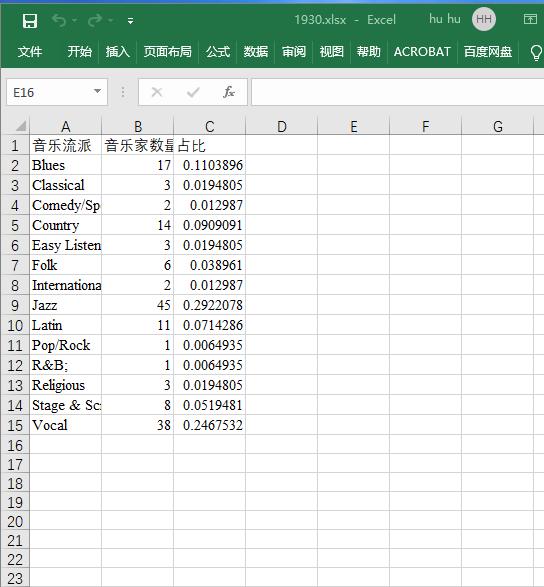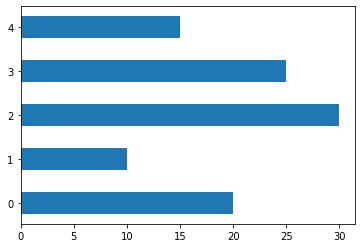一,要读取的数据的格式:

二,数据读取部分:
b站视频参考:https://www.bilibili.com/video/BV14C4y1W7Nj?t=148
# 1930 workbook=xlrd.open_workbook('1930.xlsx') sheet= workbook.sheet_by_index(0) A1=[] B1=[] # sheet.cell_value(i,0):第i行的第0个元素 for i in range(1,sheet.nrows): A1.append(sheet.cell_value(i,0)) B1.append(sheet.cell_value(i,1)) if len(A1)!=len(B1): print("False") drawBar(A1,B1,1930)三,画图函数
1. def drawBar(Music_genre,singer_num,year)
参数介绍
参数名 参数含义 Music_genre 音乐流派名称list singer_num 音乐流派对应音乐家数量list year 读的文件的年份(因为源代码是从1840到2020的) def drawBar(Music_genre,singer_num,year): arr_len=len(Music_genre) # 由循环得到一个字典,key是音乐流派,value是这个音乐流派对应的音乐家的数量 i=0 dict_music_singer={} while i<arr_len: dict_music_singer[Music_genre[i]]=singer_num[i] i=i+1 # 注释1 pyplot.bar(x=0, bottom=range(arr_len), height=0.3, width=singer_num, orientation="horizontal") # 注释2 pyplot.yticks(range(arr_len),Music_genre) # 加title,展示图像 pyplot.title(year) pyplot.show() ... ... drawBar(A1,B1,1930)注释1:
""" 水平条形图,需要修改以下属性 orientation="horizontal" """ import numpy as np import matplotlib.pyplot as plt # 数据 N = 5 x = [20, 10, 30, 25, 15] y = [0,1,2,3,4] # 绘图 x= 起始位置, bottom= 水平条的底部(左侧), y轴, height 水平条的宽度, width 水平条的长度 p1 = plt.bar(x=0, bottom=y, height=0.5, width=x, orientation="horizontal") pyplot.bar(range(arr_len),singer_num,align='center') pyplot.bar(x=0, bottom=range(arr_len), height=0.5, width=singer_num, orientation="horizontal") # 展示图形 plt.show()
注释2:plt.xticks的第一个参数和plt.plot的第一个参数一样,第二个参数是和第一个参数相同长度的list此例中用来代替横坐标
import matplotlib.pyplot as plt x = [1, 2, 3, 4] y = [1, 4, 9, 6] labels = ['Frogs', 'Hogs', 'Bogs', 'Slogs'] plt.plot(x, y) # You can specify a rotation for the tick labels in degrees or with keywords. plt.xticks(x, labels, rotation='vertical') # Pad margins so that markers don't get clipped by the axes plt.margins(0.2) # Tweak spacing to prevent clipping of tick-labels plt.subplots_adjust(bottom=0.15) plt.show()
1.1 效果:

1.2 完整代码
import pandas as pd import numpy as np import xlrd from matplotlib import pyplot def drawBar(Music_genre,singer_num,year): arr_len=len(Music_genre) i=0 dict_music_singer={} while i<arr_len: dict_music_singer[Music_genre[i]]=singer_num[i] i=i+1 #pyplot.bar(range(arr_len),singer_num,align='center') pyplot.bar(x=0, bottom=range(arr_len), height=0.3, width=singer_num, orientation="horizontal") pyplot.yticks(range(arr_len),Music_genre) pyplot.title(year) pyplot.show() # 1930 workbook=xlrd.open_workbook('1930.xlsx') sheet= workbook.sheet_by_index(0) A1=[] B1=[] for i in range(1,sheet.nrows): A1.append(sheet.cell_value(i,0)) B1.append(sheet.cell_value(i,1)) if len(A1)!=len(B1): print("False") drawBar(A1,B1,1930) # 1940 workbook=xlrd.open_workbook('1940.xlsx') sheet= workbook.sheet_by_index(0) A2=[] B2=[] for i in range(1,sheet.nrows): A2.append(sheet.cell_value(i,0)) B2.append(sheet.cell_value(i,1)) if len(A2)!=len(B2): print("False") drawBar(A2,B2,1940) # workbook=xlrd.open_workbook('1950.xlsx') sheet= workbook.sheet_by_index(0) A3=[] B3=[] for i in range(1,sheet.nrows): A3.append(sheet.cell_value(i,0)) B3.append(sheet.cell_value(i,1)) if len(A3)!=len(B3): print("False") drawBar(A3,B3,1950) # 6 workbook=xlrd.open_workbook('1960.xlsx') sheet= workbook.sheet_by_index(0) A4=[] B4=[] for i in range(1,sheet.nrows): A4.append(sheet.cell_value(i,0)) B4.append(sheet.cell_value(i,1)) if len(A4)!=len(B4): print("False") drawBar(A4,B4,1960) # workbook=xlrd.open_workbook('1970.xlsx') sheet= workbook.sheet_by_index(0) A5=[] B5=[] for i in range(1,sheet.nrows): A5.append(sheet.cell_value(i,0)) B5.append(sheet.cell_value(i,1)) if len(A5)!=len(B5): print("False") drawBar(A5,B5,1970) # workbook=xlrd.open_workbook('1980.xlsx') sheet= workbook.sheet_by_index(0) A6=[] B6=[] for i in range(1,sheet.nrows): A6.append(sheet.cell_value(i,0)) B6.append(sheet.cell_value(i,1)) if len(A6)!=len(B6): print("False") drawBar(A6,B6,1980) # 9 workbook=xlrd.open_workbook('1990.xlsx') sheet= workbook.sheet_by_index(0) A7=[] B7=[] for i in range(1,sheet.nrows): A7.append(sheet.cell_value(i,0)) B7.append(sheet.cell_value(i,1)) if len(A7)!=len(B7): print("False") drawBar(A7,B7,1990) # 2000 workbook=xlrd.open_workbook('2000.xlsx') sheet= workbook.sheet_by_index(0) A8=[] B8=[] for i in range(1,sheet.nrows): A8.append(sheet.cell_value(i,0)) B8.append(sheet.cell_value(i,1)) if len(A8)!=len(B8): print("False") drawBar(A8,B8,2000) # workbook=xlrd.open_workbook('2010.xlsx') sheet= workbook.sheet_by_index(0) A9=[] B9=[] for i in range(1,sheet.nrows): A9.append(sheet.cell_value(i,0)) B9.append(sheet.cell_value(i,1)) if len(A9)!=len(B9): print("False") drawBar(A9,B9,2010) # # # workbook=xlrd.open_workbook('2020.xlsx') # sheet= workbook.sheet_by_index(0) # A2=[] # B2=[] # for i in range(1,sheet.nrows): # A2.append(sheet.cell_value(i,0)) # B2.append(sheet.cell_value(i,1)) # if len(A2)!=len(B2): # print("False") # drawBar(A2,B2,2020)以上就是python读取excel数据并且画图的实现示例的详细内容,更多关于python读取excel数据并且画图的资料请关注python博客其它相关文章!
- << 上一篇 下一篇 >>
python读取excel数据并且画图的实现示例
看: 1891次 时间:2021-04-02 分类 : 数据分析
- 相关文章
- 2021-12-20python数据挖掘使用Evidently创建机器学习模型仪表板
- 2021-12-20Python多进程共享numpy 数组的方法
- 2021-12-20python数据分析近年比特币价格涨幅趋势分布
- 2021-12-20python调用matlab的方法详解
- 2021-12-20python学习与数据挖掘应知应会的十大终端命令
- 2021-07-20pandas中NaN缺失值的处理方法
- 2021-07-20Python数据分析入门之数据读取与存储
- 2021-07-20Python 如何读取字典的所有键-值对
- 2021-07-20如何获取numpy的第一个非0元素索引
- 2021-07-20Python机器学习之KNN近邻算法
-
搜索
-
-
推荐资源
-
Powered By python教程网 鲁ICP备18013710号
python博客 - 小白学python最友好的网站!